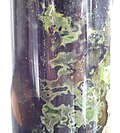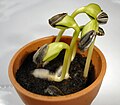A photosynthetic pigment (accessory pigment; chloroplast pigment; antenna pigment) is a pigment that is present in chloroplasts or photosynthetic bacteria...
4 KB (406 words) - 05:48, 24 June 2024
Photosynthesis (redirect from Photosynthetic)
energy is absorbed by the reaction centers, proteins that contain photosynthetic pigments or chromophores. In plants, these proteins are chlorophylls (a...
109 KB (11,776 words) - 19:45, 6 August 2024
share the possession of photosynthetic pigments, which absorb and release energy that is later used by the cell. These pigments in addition to chlorophylls...
32 KB (3,908 words) - 20:24, 18 April 2024
Chloroplast (redirect from Chloroplast pigment)
that conducts photosynthesis mostly in plant and algal cells. The photosynthetic pigment chlorophyll captures the energy from sunlight, converts it, and...
194 KB (18,825 words) - 19:04, 12 August 2024
Chlorophyll a (category Photosynthetic pigments)
most photosynthetic organisms to release chemical energy but is not the only pigment that can be used for photosynthesis. All oxygenic photosynthetic organisms...
19 KB (1,559 words) - 12:01, 28 February 2024
Chlorophyll (category Photosynthetic pigments)
JSTOR 1539668. Gilpin L (21 March 2001). "Methods for analysis of benthic photosynthetic pigment". School of Life Sciences, Napier University. Archived from the...
35 KB (3,529 words) - 15:32, 25 July 2024
Orange (colour) (section Pigments and dyes)
potatoes, and oranges, comes from carotenes, a type of photosynthetic pigment. These pigments convert the light energy that the plants absorb from the...
66 KB (7,763 words) - 14:18, 26 July 2024
Photopigment (category Photosynthetic pigments)
proteins of the retina. Photosynthetic pigments convert light into biochemical energy. Examples for photosynthetic pigments are chlorophyll, carotenoids...
3 KB (328 words) - 02:33, 16 July 2021
of Earth's photosynthetic productivity and convert solar energy into biomass-stored chemical energy at the rate of ~450 TW. Some pigments such as B-phycoerythrin...
20 KB (2,455 words) - 19:39, 25 May 2024
electron source. Electron donors include H2, H2S, S. The major photosynthetic pigment in these bacteria is Bacteriochlorophylls c or d in green species...
32 KB (3,209 words) - 06:16, 27 April 2024
blue light. Accessory pigments such as carotenes and xanthophylls harvest some green light and pass it on to the photosynthetic process, but enough of...
20 KB (2,772 words) - 17:44, 14 December 2023
Bilin (biochemistry) (redirect from Bile pigment)
bilirubin and biliverdin), and phycocyanobilin, the chromophore of the photosynthetic pigment phycocyanin, in algae and plants. In plants, bilins also serve as...
8 KB (966 words) - 00:12, 3 May 2024
the different photosynthetic species, with no homology among the major groups. The complexes consist of proteins and photosynthetic pigments and surround...
14 KB (1,746 words) - 21:25, 21 May 2024
unique photosynthetic pigment, divinyl-chlorophyll, to absorb light and acquire energy. Prochlorophyta lack red and blue phycobilin pigments and have...
5 KB (505 words) - 00:13, 19 May 2024
called radiotrophic fungi, appear to be able to use melanin as a photosynthetic pigment that enables them to capture gamma rays and harness this energy...
59 KB (6,459 words) - 16:54, 14 July 2024
Chlorophyll c (category Photosynthetic pigments)
marine algae, including the photosynthetic Chromista (e.g. diatoms and brown algae) and dinoflagellates. These pigments are characterized by their unusual...
10 KB (626 words) - 08:49, 30 May 2024
chlorophyll. Chlorophylls are magnesium-containing chlorins and occur as photosynthetic pigments in chloroplasts. The term "chlorin" strictly speaking refers to...
8 KB (639 words) - 19:19, 23 January 2024
the main role of which is to conduct photosynthesis, by which the photosynthetic pigment chlorophyll captures the energy from sunlight and converts and stores...
94 KB (11,418 words) - 16:24, 5 March 2024
evolution of eukaryotes during the Paleoproterozoic. Cyanobacteria use photosynthetic pigments such as various forms of chlorophyll, carotenoids, phycobilins...
179 KB (17,664 words) - 18:55, 8 July 2024
Distinguishable from other phototrophic bacteria, they utilize a unique photosynthetic pigment, bacteriochlorophyll g and are the only known Gram-positive phototroph...
11 KB (947 words) - 04:39, 27 July 2024
Phycobilin (redirect from Phycobilin pigments)
chromophore which makes them coloured. They are unique among the photosynthetic pigments in that they are bonded to certain water-soluble proteins, known...
7 KB (725 words) - 05:05, 24 January 2024
unstable pigment that undergoes a physical or chemical change upon absorbing a particular wavelength of light; also see Photosynthetic pigment, molecules...
1,004 bytes (155 words) - 10:34, 8 March 2020
and heat shock protein (HSP)-21], genetic template stability and photosynthetic pigment activation. . Application of exogenic glutamine limiting this process...
31 KB (3,818 words) - 15:54, 2 July 2024
and are without flagella. Their chloroplasts contain the green photosynthetic pigments chlorophyll-a and -b. In ideal conditions cells of Chlorella multiply...
22 KB (2,527 words) - 21:15, 9 August 2024
useful to normalise C concentration to Chlorophyll a (an important photosynthetic pigment) to account for specific biomass. As far back as 1905, marine researchers...
7 KB (925 words) - 01:03, 18 May 2024
Porphyrin (category Photosynthetic pigments)
trace amounts of nickel and vanadyl porphyrins.[citation needed] In non-photosynthetic eukaryotes such as animals, insects, fungi, and protozoa, as well as...
25 KB (2,304 words) - 16:20, 3 August 2024
origin of plastids from cyanobacteria. Glaucophytes contain the photosynthetic pigment chlorophyll a. Along with red algae and cyanobacteria, they harvest...
10 KB (1,011 words) - 02:24, 28 March 2024
proteins that include various photosynthetic pigments and redox carriers. For this reason they are considered to be photosynthetic units. They occur in 2 sizes:...
3 KB (239 words) - 06:39, 3 December 2023
Thylakoid (redirect from Photosynthetic apparatus)
site of the light-dependent reactions of photosynthesis with the photosynthetic pigments embedded directly in the membrane. It is an alternating pattern...
37 KB (4,369 words) - 21:49, 8 May 2024




















